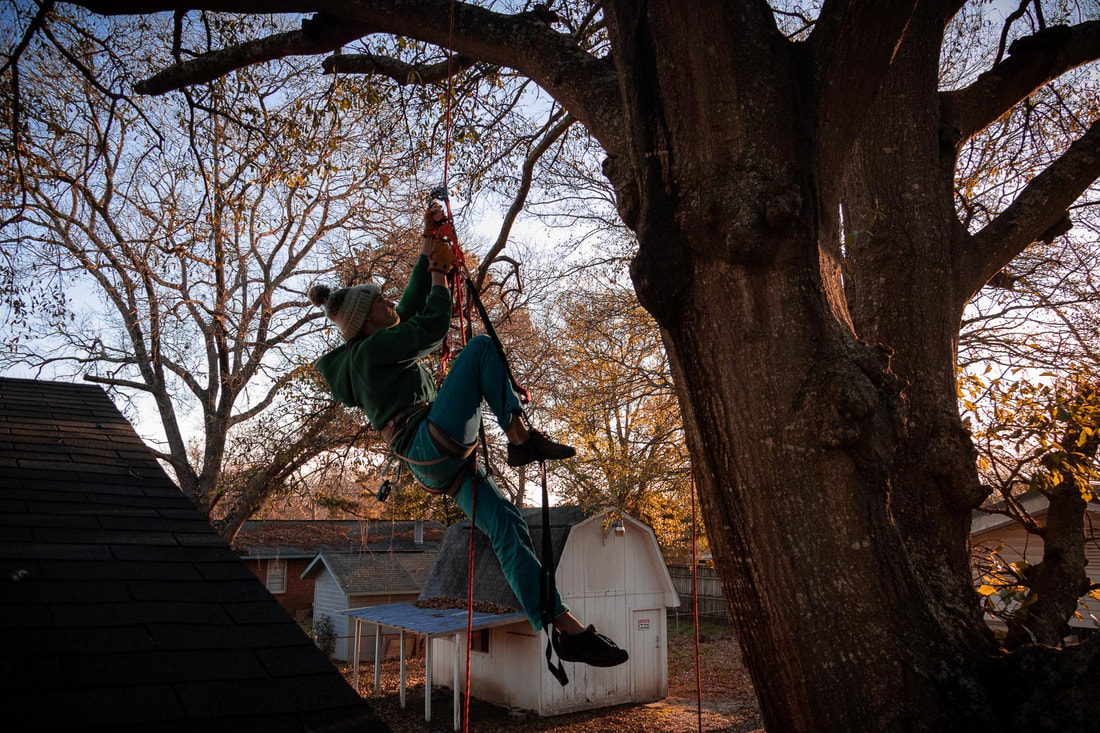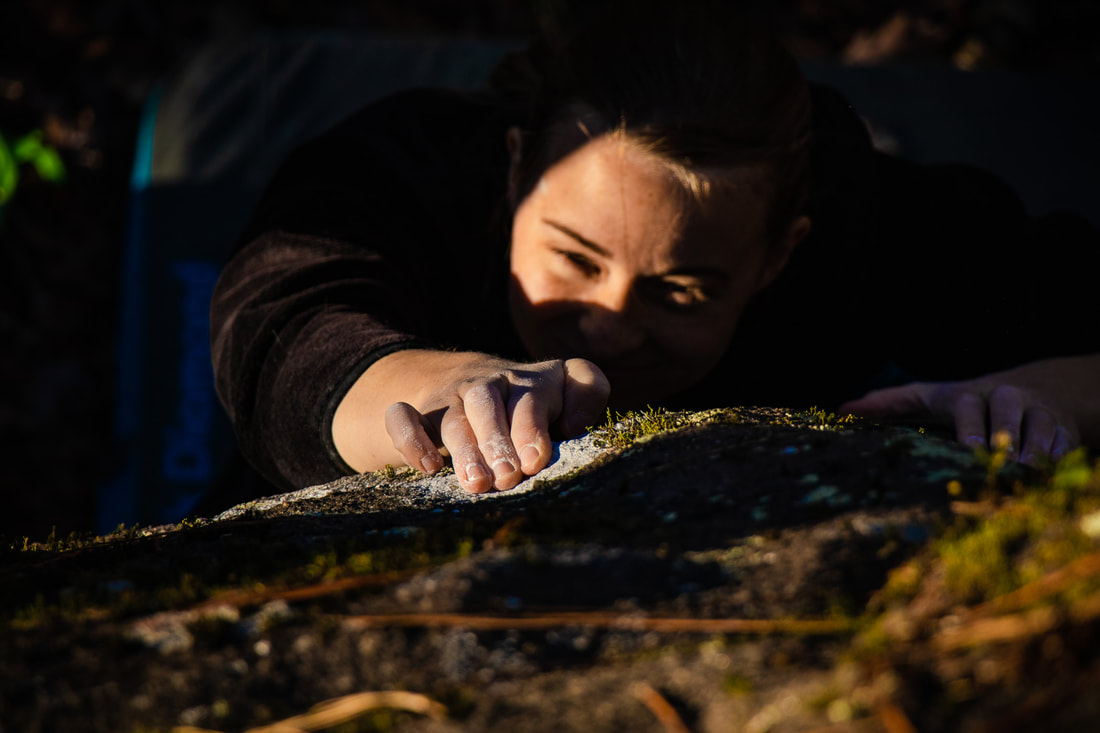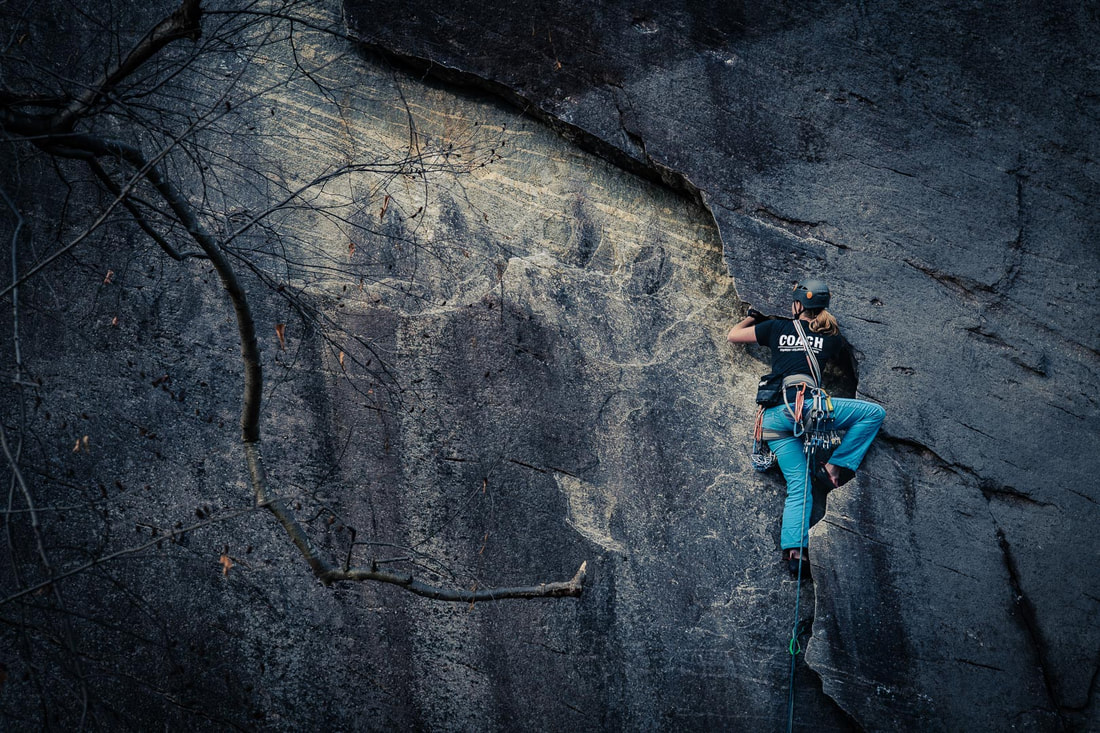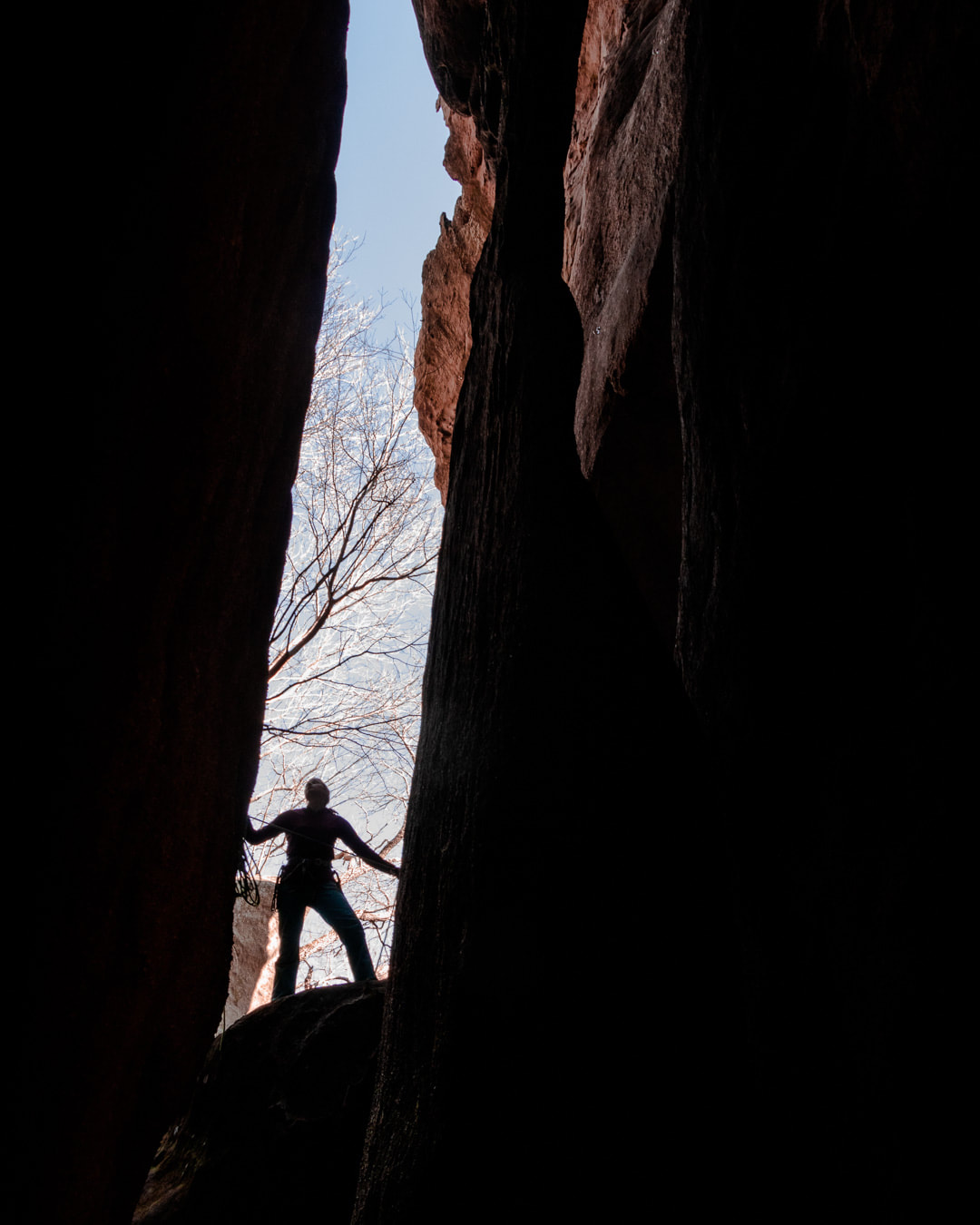Cover photo is by the author Jesse Montgomery. This is an example of how being an explorer has helped keep him climbing while living in a "climbing desert."
My climbing journey began when I went to college in Colorado. A friend dragged me to our school’s subpar rock wall in a dark, dusty corner of the gym. I watched skeptically as he grunted and struggled up the greasy, plastic holds, and listened dutifully as he expounded the intricacies of the Yosemite Decimal System and how to grab slopers.
Then it was my turn.
I slapped my way up what I was convinced was the hardest bouldering route in the gym. As I grabbed the finishing jug and awkwardly dropped down onto the dirty foam mat below, something must have clicked subconsciously in my mind. The next week I went along again, this time less reluctantly.
The week after I went on my own.
Some time later I began my transition to climbing outdoors, and it wasn’t long before I experienced, firsthand, the wonderfully addictive nature of rock climbing. I spent every weekend I could running around in Colorado’s Front Range with whomever I could drag along. Hungrily, I absorbed every bit of climbing information - devouring climbing books and watching every climbing video on YouTube, twice. I learned to clip bolts, place gear, build anchors, rappel, when to run it out, and when to retreat.
On breaks from school, I went to California and Utah, or back to Arizona to visit my parents. Like a prophet, I enthusiastically shared my newly discovered path to enlightenment with obliging family members and old high school friends. I had been to the mountaintop and it was my duty to share my newfound knowledge to all who would listen.
On these breaks I made my pilgrimage to the mythical cliffs and crags of Yosemite, Joshua Tree, Tahquitz, Bishop, Zion, and Indian Creek. Back at school I roamed the peaks in my own backyard, Rocky Mountain National Park, Eldorado Canyon, and Shelf Road.
Then it was my turn.
I slapped my way up what I was convinced was the hardest bouldering route in the gym. As I grabbed the finishing jug and awkwardly dropped down onto the dirty foam mat below, something must have clicked subconsciously in my mind. The next week I went along again, this time less reluctantly.
The week after I went on my own.
Some time later I began my transition to climbing outdoors, and it wasn’t long before I experienced, firsthand, the wonderfully addictive nature of rock climbing. I spent every weekend I could running around in Colorado’s Front Range with whomever I could drag along. Hungrily, I absorbed every bit of climbing information - devouring climbing books and watching every climbing video on YouTube, twice. I learned to clip bolts, place gear, build anchors, rappel, when to run it out, and when to retreat.
On breaks from school, I went to California and Utah, or back to Arizona to visit my parents. Like a prophet, I enthusiastically shared my newly discovered path to enlightenment with obliging family members and old high school friends. I had been to the mountaintop and it was my duty to share my newfound knowledge to all who would listen.
On these breaks I made my pilgrimage to the mythical cliffs and crags of Yosemite, Joshua Tree, Tahquitz, Bishop, Zion, and Indian Creek. Back at school I roamed the peaks in my own backyard, Rocky Mountain National Park, Eldorado Canyon, and Shelf Road.
As my time in college came to an end, I eagerly awaited to learn where my future job would be taking me. As I was entering active-duty military, it was less choosing and more being told where I was going to live. I scanned the possibilities. Job openings were available for me in Utah, Colorado, and California. Googling the nearest climbing areas, my excitement grew as I imagined setting out after work and on the weekends to explore the nearby crags.
On the day I received the news, I hurriedly tore open my envelope and my heart sank - smack dab in the middle of Georgia. A quick Google search confirmed my fears, middle Georgia is a “climbing desert.”
The nearest, well-established climbing area was a six-hour drive away. The nearest climbing gym still a two-hour drive north. Don’t get me wrong, Georgia has some beautiful areas and wonderful people, but as someone who’s entire life had been consumed by climbing, I could only see visions of my future self sitting on the couch in my sweatpants, struggling to get the last few Pringles out of the bottom of the can.
I had to find another way.
Be a Goal Setter
As climbers, most of us are natural goal-setters.
The second we blow the crux move on a route or boulder, after a brief temper tantrum, we go home and do a few extra pull ups with the intention of coming back next weekend and trying again. Thus, we have a “project,” and, if you’re anything like me, the project consumes nearly every waking moment. We grind out that extra hangboard session, scour YouTube for the perfect ab workout, and wake up in a cold sweat thinking about how, if we had just used the thumb catch on that side-pull, it might have gone down last weekend.
This is the power of setting goals. A good goal can motivate us beyond what we may ordinarily be willing to do. What I propose, however, is a different kind of goal setting. Without constant access to climbing, setting goals becomes much more important. It provides a source of inspiration and framework for your training.
The first step is to determine a long-term goal: Something you want to accomplish in anywhere from two to five years and something that will fuel your fire – something that excites you! Your long-term goal must be clear and compelling. It should be highly focused and have a clear and defined end point, and most importantly, it must be challenging enough to push you further than you would have otherwise gone. This goes beyond just sending that sweet 5.12 at your local crag. This goal should exceed your current abilities and compel you to learn new skills and new ways of training.
For my super-awesome-climber wife and me, this goal is climbing the Nose on El Cap (yes, I know "it’s cliche,” but it’s considered the best rock climb in the world for a reason right?). Prior to setting this goal, neither of us had aid climbed a day in our lives, nor had we done a route longer than five or six pitches. Audacious? You bet. But picking your long-term goal is just the first step to leveraging the power of goal setting.
Next, ask yourself, “What do I need to accomplish in order to make this goal a reality?” These become your short-term goals, sign-posts on the path to your long-term goal. These can include fitness benchmarks, new skills, routes and boulders, really anything that contributes meaningful progress towards your ultimate, long-term goal. For my wife and me, this included objectives like hanging for 10 seconds on the 7mm edge, working our way through the drills in Chris McNarama’s How to Bigwall Climb book, and climbing our first 1000 foot route.
These crazy, long-term goals can be overwhelming when staring at them head on, but much like a long climb, they can be broken down pitch-by-pitch. We knew we would have a long way to go before we were ready for the Nose, so we gave ourselves smaller goals to stay motivated and track our progress.
Each time you achieve a short-term goal, acknowledge, and celebrate it, your brain releases dopamine, the neurotransmitter responsible for pleasure, which then encourages you to continue towards your next short-term goal. This approach takes advantage of your brain's chemistry.
Setting a long-term goal and breaking it down into many short-term goals has played a vital role in our progress both as climbers and as passionate and fulfilled individuals.
Be Creative
Lacking access to any real rock, or even a climbing gym, a little creativity is required to train effectively. We learned that you don’t always need a hip rock gym with an attached brewery, coffee shop, cafe, gear shop, work area, day care, open mic poetry night, and a speed wall. In fact, these amenities can distract us from staying focused on our goals and getting stronger every day.
The first step to unlocking your own creativity is determining where you are in your climbing through honest self-reflection and assessment. This can be done with the help of a coach or climbing partner, but most of us generally know where our weaknesses lie. When we say we don’t like climbing steep routes or technical slabs, it’s usually because we lack the necessary skill or strength. Comparing where we are with where we want to go (our goals) is how we identify gaps in our climbing. Without the luxury of abundant rock and climbing gyms nearby, closing those gaps requires a look at the tools you have available and how you can use them to reach your goals.
Can’t bolt a hangboard to your wall? Use a doorframe or hang some rock rings from a tree. Lock off strength needs work? Do inverted rows on the underside of your table. Need to practice footwork? Find a brick building and traverse away. The tools you need are all around you. When you tap into your creative mind, you can begin to see solutions where others might see obstacles.
Our creativity eventually led to an eclectic collection of training tools, tailored to meet our needs. Sure, we didn’t have a climbing gym, but we did have a park with trees down the road, where we could hang up a set of gymnastic rings. To keep our finger tendons topped-up we started with a set of Metolious Rock Rings which we could put up just about anywhere. Keeping our goal in mind of one day climbing the Nose, we knew our crack climbing skills needed some work. The solution came in the form of a few 2x4s from the local hardware store and voila! Despite having very little carpentry skills, we built ourselves a 10-foot-long, adjustable crack climbing machine. Suddenly, through a little creativity, we had a way to train our large pulling muscles, sculpt our thick, juicy finger tendons, and practice the masochistic art of crack climbing.
It may not have been the sleek, high-end climbing gym we were used to, but it served its purpose in making us stronger and more well-rounded. All climbers naturally display creativity when we find just the right moves to get us to the anchors or unlock a tricky aid sequence. Applied in the right way, this creative power can be used to overcome our circumstances and reach our goals.
Be an Explorer
Climbing has always had a rich history of exploration, whether it’s summiting the unclimbed peaks of the Himalaya or setting off into the desert in search of the next great tower. Now it’s your turn to join the ranks of Edmund Hillary and Reinhold Messner. When a search on Mountain Project only reveals a large, demoralizing blank spot on the map, it may fall on you to carry on the tradition of climbing’s great explorers before you.
The truth is, rocks are everywhere. The past two years of scouring our “climbing desert” for decent rock has not only led us on some hilarious adventures, but has also revealed a few gems right in our own backyard. The keys to exploring and discovering untapped potential in a given area are keeping an open mind and staying persistent.
When driving or hiking, keep your eyes peeled. That grimy, roadside boulder may just reveal a 5-star problem with a little TLC. Even buildings, walls, and trees can provide some great climbing challenges. In our case, through scouring the internet, I heard mention of a small bouldering area about an hour to the north. Throwing our dusty, old bouldering mat on my back we hiked deep into the woods, not sure what we would find. We arrived, sweaty and bug bitten, at some crumbly, moss-covered, disappointing-looking blocks. Keeping an open mind, we cleaned off the holds, chalked up and explored what middle Georgia had to offer. We were pleasantly surprised to find some good quality granite. We returned several times (never again in the summer though, gross) and had a blast making up boulder problems and putting up our own first ascents. Not all our exploratory trips were so successful, however.
Our first expedition had us scrambling through snake infested brambles and dodging huge banana spiders for 45 minutes only to reach an area covered in trash and broken glass - not ideal. Another found us in an active quarry roaming among industrial equipment in hopes of finding a limestone boulder or two.
When these exploratory trips end in failure, it can be tempting to turn skyward and curse the climbing gods, but this is the nature of exploration. Any good adventure must have an aspect of uncertainty. Not all your attempts will be successful, but persistence will eventually pay off. I’m not saying you’ll stumble upon the next Red River Gorge, but there is plenty of undiscovered rock just waiting to be found if you are willing to look for it.
We, in the 21st century, also have a small advantage over the great explorers of the past - the Internet. These days, you can be an explorer in the comfort of your very own sweatpants. I have spent hours scanning page after page of Google searches, hunting for any mention of exposed rock near me. Even using Google Earth is a great resource to search for rocky outcroppings. All this being said, it is still important to use good judgment when exploring your local area. Don’t get yourself into a potentially dangerous or illegal situation.
All climbers have the spirit of exploration within us. Tapping into the open minded and persistent nature of exploration is necessary to thrive in a “climbing desert” like ours. When you view your situation as an opportunity to explore and accept the possibility of failure, you open yourself up to more fulfilling and exciting experiences.
Be Intentional
If you are reading this article, climbing is most likely a large part of your life. You devote a great amount of your time and energy to it and in return, get a sense of fulfillment and joy. Climbing probably takes precedence over many of life’s other activities, much to the annoyance of bosses, friends, and significant others. It can safely be said that for you climbing is a priority.
When you don’t have constant access to a climbing gym or nearby crags, however, it can be easy to allow all of life’s distractions fill your schedule. It’s tempting to allow yourself to say, “I could drive to the park and get a pull up workout in, but I do really need to mow the lawn first.” As the author and speaker Stephen Covey often advises, “schedule your priorities; don’t prioritize your schedule.” If climbing is a priority for you, be intentional about carving out time in your day to practice your craft.
For me, the key to being intentional about my climbing and training is to write everything down. Creating a weekly or monthly schedule of my planned workouts makes it much easier to stay on course when life’s other events start to pick up. If it’s Tuesday, I simply look at what workout I scheduled for Tuesday and get it done.
When creating your weekly or monthly training plan, keep your goals in mind. A plan that is carefully crafted to meet your goals will be easier to stick to because you’ll be focused on the big picture. This is far preferable to just deciding what you will do on a given day, and it eliminates excuses like “I’m too tired” or “I have too much going on today.” If climbing really is a priority, schedule it. Your future self will thank you.
Being intentional also applies to getting out on real rock. When you live in a climbing desert, trips to the nearest, well-developed crag are more committing. They require many hours of driving, staying overnight, planning out food, and everything else that goes into a multi-day trip. I have found that unless you make a definitive plan, weekends can melt away and before you know it, your alarm is buzzing again on Monday morning. Instead of saying, “We should head up to Tennessee this fall,” the intentional climber says, “Lets climb at Tennessee Wall for two days the weekend of September 19th.” When a trip is on the calendar, everything else tends to fall into place, and you’ll have all the more reason to keep training hard.
I have also found that much of the day at the crag is eaten up by deciding which wall to go to, where to warm up, which projects everyone wants to try, and what the plan is for lunch. In order to maximize your limited amount of time, it’s best to do your research before-hand, pulling out the guidebook in advance and planning out where you will warm up and which projects you want to work on. This is the difference between doing three pitches in a day and getting in ten. After all, you drove all that way, why not make the most of your time?
After a long week of 9 to 5, it is easy to stay up late Friday night, sleep in all day Saturday, do laundry on Sunday, and head back to work Monday. By being intentional, we can break this cycle. Intentionally planning your training and climbing provides a means to improve and get more fulfillment out of your climbing. When you look back on your life, you won’t remember the days and weekends you spent laying around, you’ll remember the incredible adventures and experiences you had in the mountains doing what you love.
Be Present
When my wife and I first moved to Georgia, we were constantly comparing the climbing scene here to our home crags in Colorado and California. This led to a lot of discontentment. We wished we were somewhere else; somewhere with soaring, snow-covered peaks, sandstone towers, and smooth slabs of granite. While hopes and dreams certainly have their place when it comes to setting goals, comparing in this way is destructive.
Wherever you are, be present, be fully in that moment and in that place. Doing pull ups at the local park? Focus your mind, body, and spirit completely. Perform to the best of your ability and hold nothing back. Hunting through the woods for unclimbed boulders? Drink in the smells and sounds of nature around you, feel the sweat beading down your face, embrace the excitement and the possibility of new discovery.
The same goes for those rare times you are able to make the trip to a well-developed climbing area. Don’t waste your limited time worrying about the long drive home, or whether you packed enough granola bars. Instead focus on where you are. Allow yourself to be inspired by the magnificent rock around you, revel in the simple joy of moving over stone, and remember why you love to climb.
We don’t always get to choose where life takes us. One day you may be surrounded by beautiful mountains, the next you may find yourself stranded in a “climbing desert.” We can, however, choose how we respond. We can choose to see the opportunities instead of the obstacles. We can choose to set goals, be creative, explore, be intentional, and be present in all we do.
Embracing these five ways-of-being has helped us to stay strong and stay inspired in our climbing journey, but they have also had an impact on our lives outside of climbing. Turns out, climbing goes beyond your ability to pull hard and keep it together at the crux. Climbing may just be a key to living your best life, and to becoming the best version of yourself.






